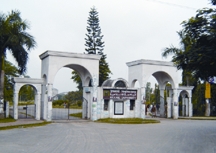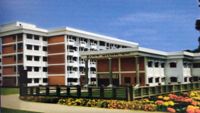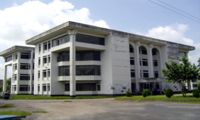Islamic University
Islamic University the first government Islamic University in the country, has been established in Kushtia after the independence of Bangladesh. The initiative to set up an Islamic trend at the university level is very old. Since the educational opportunities for the Muslims were reduced after the establishment of Calcutta University in 1857, Syed Emdad Ali, Syed Amir Ali, Editors of ‘Nabonur’ along with Syed Ameer Ali, Syed Nawab Ali Chowdhury demanded the establishment of an independent Muslim University for the Muslims in 1903. While the partition of Bengal was abolished in 1911, the Muslims of Bengal demanded the establishment of a residential Muslim University in Dhaka in 1912 where Faculty of Islamic Studies will be included. Despite the opposition of many, the British government accepted the demands of the Muslims and announced the establishment of a university in Dhaka.
The Calcutta University Commission ignored the recommendation of the main committee of the Dhaka University to set up ‘Independent Faculty of Islamic Studies’ rather recommended merely Islamic Studies Department. When the Dhaka University was established in 1921 in accordance with that recommendation, the eminent scholars of the country raised their voices again for the establishment of an Arabic University. In March 1913, a committee named ‘Anjumane Ulamaye Bangala’ was formed in Bogra district to establish an Arabic University with Mawlana Akram Khan as Secretary and Mawlana Moniruzzaman Islamabadi as Joint Secretary. Mawlana Moniruzzaman Islamabadi took initiative in 1915 individually to collect fund in order to set up an Arabic University over 600 bighas of land at the foot of Deyang Hill of Patiya Thana under Chittagong District. In 1929, the students of Jamiat-e-Talabaye Arabia in Calcutta Alia Madrasah also demanded the establishment of an Islamic University. And several dailies, including Mawlana Akram Khan’s Dainik Azad (August 10, 1965), played a vital role in support of the demand.
Mawlana Shawkat Ali laid the foundation stone of the first private Islamic University in undivided India in 1935. The then Chief Minister of undivided Bengal, Sher-e-Bangla AK Fazlul Huq announced the establishment of an Islamic University in 1939 at an Award Ceremony held at the Alia Madrasah in Calcutta. With this, the proposal of Mawlana Islamabadi to the National Assembly in 1940 enforced to establish the Islamic University. Mawla Box Committee in 1941, Syed Moazzem Uddin Hossain Committee in 1947-48, Mawlana Akram Khan Committee in 1949, Ataur Rahman Khan Commission in 1957, SM Sharif Education Commission in 1958, SM Hossain Commission in 1963 recommended the same to establish an Islamic Arabic University on 27 September 1964. In the same year, Governor Monaim Khan announced the establishment of an Islamic University in Kashemabad, Barisal and in Chittagong on 27 February 1965 in the face of strong public demand. Mawlana Abdul Hamid Khan Bhasani established an Islamic University at Santush of Tangail in 1974.

The government of Bangladesh announced the establishment of the Islamic University on 01 December 1976. According to the letter dated January 21, 1977 (SIV/5 -88/76/64Edn), a high-powered 7 members Commission with Prof. Dr. MA Bari, former Vice Chancellor of Rajshahi University and the Chairman University Grants Commission was formed to study the feasibility of establishing an Islamic University in the country. Bari Commission submitted its report on October 20, 1977 with a positive recommendation. The Commission observed that this university would serve such objectives as; 1. To coordinate Islamic Education with different branches of Humanities and Sciences sectors. 2. To improve Madrasah Education in a new way to make it up-to-date. 3. To arrange higher education and research in different branches of Islamic Education. 4. To establish unity in the Muslim Society by abolishing the two-way education system. 5. To end the conflict between the so-called non-Islamic and Islamic Education through the introduction of Islamic Education. 6. To revive the whole environment of Islamic teachings through the creation of Muslim Scholars. 7. To produce students to be specialized in Islamic Education and Humanities and Sciences at the Under-graduate and Post-graduate levels having high status in working life to execute the hopes and aspirations of the mass people, having faith in Islamic values.
The report also recommended that setting up of a number of departments under different faculties which include (1) Al-Quran was Ulumul Quran, (2) Ulumut Tawheed Wad Da'wah, (3) Al-Hadith wa Ulumul Hadith, (4) Ash-Shariah wa Usulus Shariah, and (5) (Al-Fal Safaah Wat-Tasauf wal-Akhlaq under the Faculty of Theology and Islamic Studies; (1) Arabic Language and Literature, (2) Bengali Language and Literature, (3) History and Culture of Islam, (4) Economics, (5) Public Administration, (6) Comparative Theology, (7) Linguistics under the Faculty of Humanities and Sociology; (1) Physics, (2) Mathematics, (3) Chemistry, (4) Botany, and (5) Zoology under the Faculty of Commerce and the Faculty of Science. With these, the report also mentions to have Teacher Training Institute, Bureau of Translation and Publication, Institute for Middle Eastern Studies and Language Education in the Muslim World along with the establishment of a School-Madrasah.
The Heads of State and Governments of Muslim Countries in a summit, organized by the Organization of Islamic Countries (OIC) held in Meccah from 31 March to 8 April 1977, recommended to establish Islamic Universities in different member countries. And based on that recommendation, Professor ANM Momtaz Uddin Chowdhury was appointed as Project Director on 9 February 1979 for establishing an Islamic University in Bangladesh.
The foundation stone of the Islamic University, the leading Islamic Institution of higher education for the people of the south-west part of the country was laid by the martyred President Ziaur Rahman on 22 November 1979 over a land of 175 acres at Shantidanga-Dulalpur village located beside the Kushtia-Jhenaidah highway, 24 kilometer south of Kushtia town. On 18 July 1980, the Islamic University was shifted from Shantidanga-Dulalpur to Board Bazaar, Gazipur.

The Islamic University Act (Act No. 27, 1980) was passed in the Parliament on 27 December 1980. The Act empowers the University to conduct educational and administrative functions. The Islamic University will be regulated and run by the University Grants Commission (UGC). The Prime Minister will be the Chancellor of the University and the Vice Chancellor, nominated by the Chancellor, will perform the administrative duties of the University. On January 1, 1981, Professor ANM Momtaz Uddin Chowdhury was appointed as the first Vice-Chancellor. Pursuant to Section IV (B) of the Islamic University (Amendment) Ordinance 1982 (42), 50 acres of land was acquired at Board Bazar, Gazipur. On July 21, 1983, Hussein Muhammad Ershad laid the foundation stone of the university officially for the second time at Board Bazar, Gazipur.
In the academic year 1985-86, 300 students were admitted in ‘Al-Quran wa Ulumul Quran’ and ‘Ulumut Tawheed Wad Da'wah Departments’ under the Faculty of Theology and Islamic Studies and in Accounting Science and Management Department under the Faculty of Humanities and Sociology. On 28 June 1986, the Islamic University officially launched its activities at Board Bazar, Gazipur with 8 teachers. 100 marks on Arabic and Islamic was made compulsory for college students and 100 marks on English was made obligatory for Madrasah students. From 1985-86 to 1987-88, a provision was made to admit 50% students of Madrasah background in each department.
As per the decision of the cabinet of 3 January 1989, all the activities of the university were declared closed. On 24 February 1990, the University was relocated from Gazipur to Kushtia by an order of the then government. The first female teacher was recruited in the university in 1990 and admission of the female students was made open in the Academic Year 1990-91. The system of students’ admission and appointment of the teachers started to introduce irrespective of race, religion, sex and caste. Until 1992, the university was run at PTI and Paramedical Buildings of Kushtia City. On November 1, 1992, the main campus of the Islamic University was shifted to Shantidanga-Dulalpur. From the academic year 1997-98, 4-Years Honors Course instead of the typical 3-Years Honors Course and Grading System was introduced from the Academic Year 2006-2007.
The Vice-Chancellor of the University conducts both the administrative and academic activities with the assistance of the Syndicate and the Academic Council of the university. The University also does have a Finance Committee, Planning and Development Committee, Works Committee, Higher Education and Research Committee, Faculty Committee, Departmental Planning Committee and Academic Committee for conducting both Academic and Administrative affairs.
At present there are 34 Departments under 8 Faculties. The Faculties and Departments are: 1. Faculty of Theology and Islamic Studies (1985): 1. Department of Al-Quran and Islamic Studies (1985), 2. Department of Dawah and Islamic Studies (1985), 3. Department of Al-Hadith and Islamic Studies (1991); 2. Faculty of Arts (2017): 1. Department of Arabic Language and Literature (1990), 2. Department of Bangla (1990), 3. Department of Islamic History and Culture (1990), 5. Department of English (1990), 6. Department of Folklore Studies (2015), 7. Department of Fine Arts (2019); 3. Faculty of Social Sciences (1985): 1. Department of Economics (1987). 2. Department of Public Administration (1990), 3. Department of Politics (2015), 4. Department of Development Studies (2017), 5. Department of Social Welfare (2017); 4. Faculty of Law (1994) (formerly Al-Qarun Wash Shariah): 1. Department of Law (1990), 2. Department of Al-Fiqh Regal Studies (2003), 3. Department of Law and Land Management (2015); 5. Faculty of Business Administration (1995): 1. Department of Accounting Science and Information Systems (1985), 2. Department of Management (1985), 3. Department of Finance and Banking (2015), 4. Marketing Department (2015), 5. Department of Human Resource Management (2017), 6. Department of Tourism and Hospitality Management (2017); 6. Faculty of Science (1994): 1. Department of Mathematics (2004) 2. Department of Statistics (2009), 3. Department of Environmental Science and Geography (2017), 7. Faculty of Engineering and Technology (2017): 1. Department of Electrical and Electronics Engineering (EEE) (1995), 2. Department of Applied Physics, 3. Department of Chemical Engineering (1995), 4. Department of Computer Science and Technology (1995), 5. Department of Information Science and Communication Engineering (1998), 6. Department of Bio-Medical Engineering (2017); 8. Faculty of Biological Sciences (2017): 1. Department of Biotechnology and Genetics Engineering (1998), 2. Department of Pharmacy (2017).
Degrees Awarded The following degrees are currently being offered at Islamic University. Graduate (Hons) Degree: BTIS, BA, BSc, BBA, BA Pharm, BSc Engr/ BEngr Post Graduate Degree: MTIS, MA, MSc, MBA, NMSc, MA Pharm, MSc Engr/ MEngr Higher Degrees: MPhil and PhD
The Islamic University currently has an International Admission Cell for the Admission of foreign students. Over the last few years, a number of foreign students have been admitted in the university. Currently, students from SAARC countries, South Asian countries, Middle Eastern countries, especially Nepal, India, Pakistan, Sri Lanka, Maldives, Bhutan, Somalia, Cambodia, Afghanistan and Indonesia can get admitted to the Islamic University as well. Presently, the number of students in the Islamic University is 15,384 (including 38 Foreigners). 247 Researchers are of M. Phil, 294 Researchers are of PhD and 694 Researchers with MPhil degrees, 510 Researchers with PhD degrees. The number of total teachers including 25 female teachers is 394 and 473 officers. The number of employees is 326.
Residential Halls There are 8 Residential Halls for the students of the university. Five for male students and three for female students like 1. Saddam Hussein Hall (1986) (475 seats), 2. Shaheed Ziaur Rahman Hall (1997) (400 seats), 3. Father of the Nation Bangabandhu Sheikh Mujibur Rahman Hall (1999) (366 seats), 4. Lalon Shah Hall (2005) (368 seats), 5. Sheikh Russell Hall (2019), 6. Khaleda Zia Hall (1994) (398 seats), 7. Bangamata Sheikh Fazilatunnesa Mujib Hall (480 seats), and 8. Deshratna Sheikh Hasina Hall (2013).

The King Fahad Bin Abdul Aziz Central Library was established at the university with the financial support of the Government of Kingdom of Saudi Arabia (KSA). The library does have ‘Bangabandhu Corner’ and Liberation War Corner along with 81,100 Books, and 17,071 Journals. All departments do have Computer Center and Departmental Library. For the students of the university, there is the Department of Physical Education and Sports, National Cadet Corps and Scouts. There are also Student-Teacher Centers and Cultural Centers, including Medical Centers, Stadiums, Gymnasiums, Press, Central Mosques, Shaheed Miner, Liberation War Sculptures, Laboratory Schools and Colleges and its own Transport System. At present, BEd. MEd, Diploma, Diploma in Library and Information Science, Junior Diploma in Chinese Language are conducted as well.
After the establishment of Islamic University, four Convocations held by this time; the First Convocation on April 20, 1993, the Second Convocation on November 5, 1999, the Third Convocation on March 28, 2002 and the Fourth Convocation on January 6, 2018. The Silver Jubilee was celebrated on November 30, 2004 to mark the 25th Anniversary of the University.

The Islamic University initially published a journal for all faculties. Later, IIER Research Journal and Islamic University Central Journal were published from the Five Faculties under the name 'The Islamic University Studies (Part A-E). At present, a separate journal is being published under the name of each faculty as well. In addition, a number of departmental journals like ‘The Quranic Studies’ under Al-Quran and Islamic Studies Department, ‘Dawah Research Journal’ under Dawah and Islamic Studies Department, ‘Hadith Research Journal’ under Al-Hadith and Islamic Studies Department, ‘Arabic Journal’ under Arabic Language and Literature Department, ‘Critics’ under the Department of English and ‘Bangla Research Magazine’ from Bangla Department are published on a regular basis.
According to Islamic University (Amendment) Act, 2006, Alia Madrasah Education Course of 3 years for Fazil (Degree) and 2 years for Kamil (Post-Graduate) were introduced in the Islamic University for a total of 5 years. According to the Act, 1,087 Fazil (Under-Graduate) and 194 Kamil (Post-Graduate) (Total 1,281) Madrasahs were affiliated under Islamic University. The first honors course was introduced in 56 Madrasahs on an experimental basis. After the establishment of Islamic Arabic University in 2015, all Madrasahs are now allied to the university since 2017.
Healthcare and Transportation Services Islamic University services include Healthcare and Transportation services too. The Islamic University Medical Center consists of 15 Doctors with a Dental Unit, an Eye Unit, an X-Ray Department and Two Ambulances and 50 Beds. There are 47 buses (31 hired) to transport students and teaching staffs in between Kushtia and Jheneidah District Towns. [ABM Saiful Islam Siddiqi]
